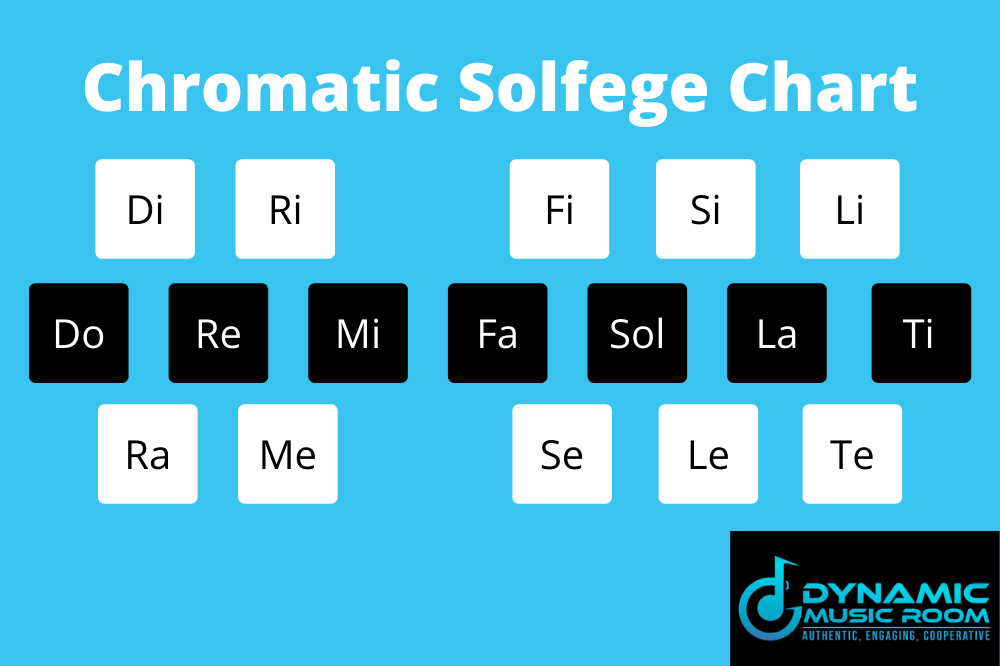Are you looking to master singing in solfege?
Do you struggle to understand what singing chromatically means?
Chromatic singing is an advanced concept, but one most musicians will come across.
Unfortunately, I’ve seen many singers give on trying to learn these ideas, and it limits their ability to internalize pitches and sing better.
But I’m here to help! This is why I made this guide for chromatic solfege.
Chromatic pitches are the ones in between the diatonic pitches noted by plain letters A-G. The chromatic solfege syllables fit in between the diatonic pitched do, re, mi, fa, sol, la, and ti. The exact syllable changes depending on the direction you’re singing.
Let’s dig into the details with helpful information, charts, and exercises.
Table of Contents
What Is Chromatic Solfege?
There are 7 diatonic pitches. We normally call them by their letter: A, B, C, D, E, F, and G.
On the piano, these are the white keys.
In between these notes, there are some half-steps or chromatic notes. These are notated by the black keys on the piano.
There are chromatic notes between A-B, C-D, D-E, F-G, and G-A.
When looking strictly at the letter names, we call the chromatic notes either a sharp (#) or a flat (b) based on if you change the letter by raising it (sharp) or lowering it (flat).
A raised F becomes F# while a lowered G becomes Gb. Both are the same pitch, but we call them different names.
The same is true with solfege.
In moveable do, the most common form of solfege, do is always the starting pitch of the major scale. After this, the scale degrees are do, re, mi, fa, sol, la, and ti.
In between these solfege pitches, there are altered solfege notes or chromatic solfege.
Like the chromatic letter names, the exact syllable depends on how you alter the notes.
Learn more in the next sections.
Going Up In Do Re Mi Chromatic Scales
When going up in scales, chromatic notes are notated with a sharp (#).
For solfege, the syllables are usually shown to be raised by changing the end vowel sound to an “-ee” sound.
Here are the syllables used when ascending.
| Scale Degree By Number | Syllable | Pronunciation |
| 1 | Do | Doe |
| 1.5 | Di | Dee |
| 2 | Re | Ray |
| 2.5 | Ri | Ree |
| 3 | Mi | Mee |
| 4 | Fa | Fah |
| 4.5 | Fi | Fee |
| 5 | Sol | Soul |
| 5.5 | Si | See |
| 6 | La | Lah |
| 6.5 | Li | Lee |
| 7 | Ti | Tee |
Note: There isn’t a raised version of Mi and Ti. These are already raised. Rarely will you ever see these altered anyway.
In solfege, if you had to, you’d just call it by the upper note.
Going Down In Chromatic Scale Singing
When going down with letter names, the notes are changed by adding a flat (b).
In solfege, we alter the syllables to an “-ay” sound.
The exception to this is lowering Re. It already makes the “-ay” sound, so we turn it into an “-ah” sound.
| Scale Degree By Number | Syllable | Pronunciation |
| 8 | Do (upper one) | Doe |
| 7 | Ti | Tee |
| 6.5 | Te | Tay |
| 6 | La | Lah |
| 5.5 | Le | Lay |
| 5 | Sol | Soul |
| 4.5 | Se | Say |
| 4 | Fa | Fah |
| 3 | Mi | Mee |
| 2.5 | Me | May |
| 2 | Re | Ray |
| 1.5 | Ra | Rah |
Note: In some solfege systems, every lowered syllable is switched to an “-ah” sound except for La which is still switched to “-ay”.
It’s a matter of preference.
Chromatic Solfege Chart
All of this is good in theory, but a chart may be more helpful to you.
In the center of this chromatic solfege chart, you’ll find the normal or diatonic pitches.
The blocks in between and above the middle row are the raised solfege.
The blocks in between and below the middle row are the lowered solfege.
Notice the syllables are written as you’d see them spelled out normally, not how they’re pronounced.
Check the tables above to see how they’re pronounced again.

Solfege Chromatic Scale Exercises
Learning the solfege chromatic scale just takes time and practice.
Part of the reason why re mi chromatic scale singing is so tricky is because you’re not familiar with it.
Even the person with little to no musical experience is at least aware of the do re mi syllables.
Usually, it’s through the Sound of Music song using the syllables. Do, a deer, a female deer, and whatnot.
Or maybe it’s through the Jackson Five’s ABC.
The altered solfege isn’t as well known. It takes more concentration from the brain and ear to imagine the notes as well as say the right syllable.
What’s the answer?
Practice, practice, practice.
Here are a few of my favorite solfege chromatic scale exercises. (Learn about the solfege minor scale.)
Tips For Chromatic Scale Exercises
These exercises are great, but doing them once isn’t enough. Here are some tips I always offer students and friends when it comes to doing these exercises.
- Start on a pitch you’re comfortable with singing.
- Pick a slow tempo or speed to start with and then speed up gradually.
- Sing along with a recording or piano.
- Try humming the notes without syllables a few times before trying the syllables.
- Don’t stick to one scale. Change the starting pitch to better develop your ear.
- Practice this a few times every day rather than practice it a hundred times one day. Gradual, over time learning is better than cramming it in.
The solfege chromatic solfege hand signs are different depending on the teacher. There isn’t a clear standard.
I like how this person does it.
Conclusion
I hope you enjoyed learning about chromatic solfege and how to do chromatic scale singing.
This is an advanced concept, but any singer will come across it eventually.
As a music teacher for over 10 years and a musician for even longer, I can’t overemphasize the importance of developing a good ear for solfege.
All musicians need a good ear, and it’s possible to develop it over time and practice.
Check out the exercises above and give it a go!

